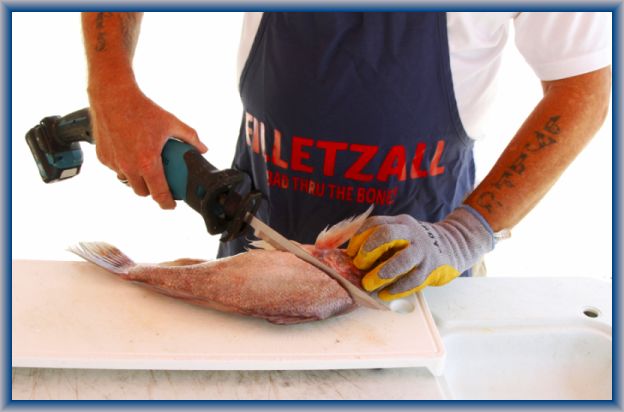
Article by:

Shannon Tompkins
Houston Chronicle
Fillet blade is a cut above rest for anglers

Designed to fit hand-held reciprocating saws, Filletzall blades developed by Houston-area charterboat captain Paul Bates give anglers frustrated with limitations of regular electric fillet knives a supercharged option for cleaning their catch.
For most anglers, enjoying a meal of fresh fish — fish they found and caught, cleaned and prepared themselves or with family or friends — is a fishing trip’s delicious coda, a welcomed opportunity to relive the experience and savor the wonderful, natural, healthy meal it provided. But between the bookends of fishing and feasting comes a penultimate step that, if not dreaded, isn’t exactly looked forward to by anglers: Cleaning the catch.
As June sets in, and with it the months-long peak season of fishing participation (and fish cleaning) in Texas, plus the approach of Father’s Day, almost all anglers are looking for a way to make that task less taxing and more efficient.
Efficiency was what angler Paul Bates ached for, quite literally.
The 53-year-old Kemah native captains a 42-foot Bertram, taking anglers into the Gulf of Mexico, where they target the smorgasbord of species found there.
Back at the dock after the end of a long day on the water, Bates’ day wasn’t over. He faced the chore of cleaning what often was a small mountain of fish — snapper, king mackerel, tuna, wahoo, amberjack, grouper.
For decades, he worked with standard fillet knives — mostly fixed blades because available electric fillet knives don’t hold up to the challenges of sawing through the thick scales and heavy bones of many fish. And even if the electric knives did work for thinner skinned fish, running them for long periods would result in, at best, their overheating or, at worst, seizing, stripping or melting gears. And that’s if there was an electric outlet close by, which often is not the case for anglers who clean their fish at dockside.
Frustrating experience
It was long, hot, tiring, frustrating work.
It would wear you out. I knew there had to be a better way,” Bates said.
He found it. And now other anglers can, too, through Bates’ Filletzall blades.
Bates, who has experience in metal work, had an idea. He removed the plastic handle from one of his favorite fillet knives, a Dexter-Russell with an 8-inch serrated blade.
He then ground and shaped the knife’s now-exposed tang to the universal shape/design of blades made to fit all electric reciprocating saws. It was challenging, exacting work, especially drilling the small hole in the tang required to make the blade fit the reciprocating saw, he said.
Bates fit the modified Dexter blade to a handheld, cordless reciprocating saw — compact versions of the two-handed reciprocating saws used in construction and demolition. The reciprocating saws, often generically termed “Sawzalls” after the Milwaukee Electric Tools version of the machine, move their blades in the same push-pull motion as electric fillet knives, but with much more power and speed. Even more important, the compact reciprocating saws are infinitely more durable, immune to overheating and just plain bulletproof than standard electric fillet knives. They can run for hours and never miss a beat. Bates used that first modified blade for a full year.
A ‘better way’
The high-carbon Dexter blade mated with a compact but powerful cordless reciprocating saw “cut through fish like butter,” Bates said. It easily sliced through heavy scales and bones of redfish, black drum, sheepshead, snapper and other species.
I cleaned every fish we brought in with it, testing it,” Bates said. “It was an unbelievably better way to clean fish.”
Even after hundreds — thousands? — of fish, the blade was still sharp enough to easily do its job.
It’s just so much easier and faster,” Bates said. “There’s just no comparison.”
Bates was not the first person to modify a fillet knife blade to fit a powerful compact reciprocating saw. A handful of other anglers and especially guides, mostly along the Gulf Coast, have been doing this themselves or taking blades to machine shops to have the tangs milled to the universal fitment for all reciprocating saws.
But none had really taken it much beyond that. Bates did.
